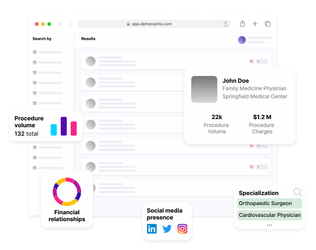Publication Mapping in Medical Affairs: How to Identify Emerging Thought Leaders with Data

PubMed alone added well over 1.5 million new citations last year, roughly 4,000 every single day.
Preprint servers, conference portals, and social channels add thousands more. Somewhere in that torrent are the next wave of key opinion leaders (KOLs) who will steer guidelines, trials, and, ultimately, prescribing habits.
But if you rely on year-old spreadsheets or gut feel, you’ll meet those voices only after a competitor has them on an advisory board.
Publication mapping offers a way out. By converting raw bibliographic data into living influence maps, it surfaces researchers whose work is accelerating right now, not only the celebrities everyone already follows.
Plug that feed into a platform like Alpha Sophia, and your medical science liaisons (MSLs) see, in one view, who is publishing novel data, how fast their citations are climbing, and whether their clinical volumes back the hype.
In this article, we’ll break down exactly what publication mapping is and why traditional KOL discovery keeps missing the mark, setting you up to act before the window closes.
What Is Publication Mapping?
Open any database, and you’ll see citation after citation, but no clear picture of influence. Publication mapping fills that gap.
At its core, it is a bibliometric workflow that transforms raw literature into an evidence-backed radar for emerging thought leadership, something a spreadsheet of last year’s KOLs simply cannot deliver.
First, the process harvests every new record that touches your mechanism of action or disease space, like PubMed, Scopus, preprint servers, and major portals, pulling them nightly through APIs.
Next, it cleans and normalises the data. Author-disambiguation algorithms ensure that “L. Chen” in Shanghai is not conflated with “Liang Chen” at Stanford, a step the University of York’s bibliometric guide flags as critical for accurate trend analysis.
Then next is scoring. Each author earns a dynamic metric that blends recency, journal impact, co-authorship breadth, and, crucially, citation velocity. Burst-detection methods, validated in information science studies, highlight researchers whose citations spike within a 6 to 12 month window, signaling rising authority long before they receive plenary invitations.
Fourth, the workflow visualises networks. Node-and-edge graphs expose clusters of collaboration and “bridge” investigators who connect otherwise siloed subspecialties, prime targets for early engagement.
Definitive Healthcare defines this mapping step as the moment you shift from raw names to actionable influence paths.
Finally, a platform like Alpha Sophia layers those bibliometrics onto real-world claims, script share, and digital reach. The result is a single dashboard that displays scientific clout and clinical impact side by side, allowing your medical affairs team to allocate its budget where the science and the patients are headed next.
Now that we’ve put a clear frame around publication mapping, the obvious question is why the traditional KOL-discovery playbook still falls short. That’s where we go next.
Start Your Omnichannel Strategy with Alpha Sophia

Common Challenges in KOL Discovery
Legacy methods weren’t built for the velocity, volume, or global spread of today’s evidence. Here are the five gaps that keep medical affairs teams in a reactive mode.
Static Lists Go Stale Overnight
A 2024 survey shows 62% of physicians changed roles or employers in just two years. An annual or even semi-annual list update can’t keep pace, leaving you courting names that no longer influence care pathways.
Volume Overload Drowns Signal
Oncology alone sees thousands of new papers every quarter. Machine-learning tools like Abstrackr have demonstrated 40%–70% first-pass workload reductions in systematic reviews, proving that algorithms can triage the flood while humans focus on insight.
Emerging Fields Lack History
Gene editing, AI diagnostics, and digital therapeutics are advancing so rapidly that citation counts often lag behind their true influence. Without burst analysis and co-authorship tracking, you’ll notice innovators only after they capture a plenary slot.
Regional and Language Bias Skews Perception
English-language journals still dominate indexing, under-representing pivotal work from Chinese, Spanish, or other regional open-access outlets. That bias distorts your KOL map and blinds you to fast-growing markets.
Time-to-Insight Lag Erases First-Mover Edge
By the time an associate professor pivots to principal investigator, advisory seats are full. Real-time publication mapping cuts that lag from months to days, so your MSL is first in the inbox.
In the next section, we’ll show how a data-driven workflow, grounded in the same mapping principles above, lets you close each of these gaps and redeploy resources where they create a measurable impact.
How Data Solves the Discovery Gap
The literature problem is not the volume, it’s the lag between data appearing online and medical affairs catching it. The fixes already live in other knowledge-intensive industries and translate cleanly to the pharmaceutical sector.
Live Harvesting Ends List Decay
APIs now sweep PubMed, Scopus, preprint servers, and major congress sites while you sleep. Automated enrichment tags every record with affiliation changes, keywords, and DOI dates so an MSL sees the alert the same day the study goes live.
That matters because 62% of U.S. physicians made some kind of career move in just two years, a churn rate that makes annual KOL refreshes pointless.
Prediction Models That Spot Influence Before It Peaks
Next, burst-detection algorithms model citation velocity. Bibliometric work in Quantitative Science Studies shows that recency-weighted bursts can forecast which authors will enter the top decile of citations with high precision months before the surge is obvious to humans.
Claims Plus Citations Show Real-World Reach
Publication heat alone is a mirage if the author sees ten patients a week. By fusing bibliometrics with longitudinal claims, more than 330 million de-identified patient journeys in the largest U.S. databases, teams see burst score, CPT volume, payer mix, and referral reach in one view.
“Conference-famous” names fall off automatically, and field hours shift toward clinicians who both shape evidence and treat large cohorts.
Automated Compliance Keeps Teams Moving
Before any invite leaves Outlook, candidate profiles can be screened against CMS Open Payments, which logged 16.16 million industry transfers worth ≈ $13 billion in 2024.
Out-of-band payments trigger instant flags, collapsing legal review from weeks to hours. Strategy then moves at the speed of science, not email threads.
Applying Publication Mapping in Medical Affairs Strategy
Publication mapping only creates value when the insight moves from a dashboard to a field plan. Below is a playbook medical-affairs teams are using today, pulled from launch rooms, not slides.
Frame the Scientific Lens
Start with a Boolean that mirrors your mechanism of action, endpoints, and patient-journey touch points.
Information-science guidance shows that strategically adding NOT terms can trim large blocks of irrelevant hits without hurting recall, saving screening hours downstream.
Freeze the query in version control so every refresh inherits the same rules.
Blend Bibliometrics with Real-World Throughput
Publication momentum shows who shapes the narrative, and claims data show who moves patients. U.S. real-world datasets now chart 330 million de-identified patient journeys, linking CPT codes, payer mix, and referral flow.
When you overlay those counts on burst scores, a community pulmonologist who sees 400 COPD cases a year instantly outranks a lab-based author with no clinic.
Score Dynamically
Static “top-ten” lists miss tomorrow’s voices. Burst-detection models built on Kleinberg’s algorithm routinely flag authors whose citation velocity spikes 6–12 months before they grab plenary slots, with predictive accuracy reported around 80%.
Re-ranking each time new citations land keeps the list honest.
Route Field Calls by Impact Density
Feed the ranked list into your CRM and overlay unmet-care pockets. Commercial white papers on omnichannel targeting report that redistributing just 20% of calls toward higher-throughput regions lifts launch metrics noticeably and frees MSL bandwidth for deeper scientific exchange.
Add Compliance to the Same Flow
Before an invite leaves Outlook, screen the HCP against CMS Open Payments, which logged 16.16 million industry transfers worth $13.18 billion in 2024.
Automated flags end the last-minute scramble with legal and keep advisory budgets within fair-market bounds.
With these five moves, publication mapping shifts from an analytics exercise to a living operating model. A light touch of platform automation keeps the mechanics invisible so that the human focus stays on the conversation and the science.
Every US physician at your fingertips. Always.

FAQs
What is publication mapping in the context of medical affairs?
It’s a live, data-driven map of who’s publishing, where, and with whom in your therapy area. Think of it as a radar that turns the daily flood of new papers into a ranked shortlist of scientists worth talking to, long before they make the speaker circuit.
Why is publication analysis important for identifying emerging KOLs?
Because the first sign of influence is almost always a flurry of fresh, well-cited papers. Spot that surge early, and you can build relationships while inboxes are still quiet, not after every competitor is already queued up.
How can data help uncover rising thought leaders not yet on KOL lists?
Algorithms watch for citation “bursts,” new co-author links, and cross-disciplinary pivots, signals humans miss when they skim abstracts manually. The data surfaces names that haven’t cracked the top-ten podium yet but are clearly on their way.
What types of filters are most useful in publication mapping?
Recency (how fresh is the work), burst score (how fast are citations climbing), real-world patient volume, cross-disciplinary reach, and any red flags in payment history. Together, they separate headline makers from real practice shapers.
Can Alpha Sophia track co-authorship networks and citation frequency?
Yes. The platform draws a living network graph for every author, showing who they publish with and how often their work gets cited so that you can see both the depth and the spread of their influence.
How often should medical affairs teams update their KOL lists using publication data?
Quarterly is safe for most therapy areas. If you’re in a fast-moving field like oncology or digital therapeutics, monthly is smarter, science shifts too quickly to wait for the next quarter.
Is publication mapping useful for niche or rare therapeutic areas?
Absolutely. In rare diseases, the author pool is tiny, so even a single burst or new collaboration stands out. Mapping helps you find the few specialists who genuinely move the needle.
Can publication trends help inform clinical trial partnerships or advisory board selections?
Definitely, rising authors with strong citation momentum and solid patient throughput make ideal principal investigators and advisory board members. You get scientific credibility and recruitment muscle in one package.
Conclusion
Publication mapping has evolved from a research side-project to the backbone of modern medical affairs. Nightly literature feeds tell you who is publishing, burst analytics reveal whose influence is accelerating, longitudinal claims confirm who actually treats patients, and automated Open Payments checks keep every outreach defensible.
When those streams run in lock-step, the lag between “new data” and “field decision” collapses. Your team arrives first, spends less, and builds relationships before the inbox flood starts, an edge that matters in a world adding more than 1.6 million PubMed citations a year.
